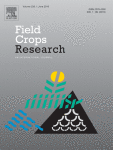Ver ítem
- xmlui.general.dspace_homeCentros Regionales y EEAsCentro Regional Santa FeEEA ReconquistaArtículos científicosxmlui.ArtifactBrowser.ItemViewer.trail
- Inicio
- Centros Regionales y EEAs
- Centro Regional Santa Fe
- EEA Reconquista
- Artículos científicos
- Ver ítem
Genetic progress in cotton lint and yield components in Argentina
Resumen
The Argentinian cotton (Gossypium hirsutum L.) breeding program was established in 1923 and since then it has released more than 40 commercial cultivars of cotton and numerous germplasm lines. Genetic progress studies have been used to evaluate the historical enhancement of different traits and to provide insights into possible improvements in future cultivars. In this context, the present study aims to estimate the genetic progress for lint yield (LY)
[ver mas...]
The Argentinian cotton (Gossypium hirsutum L.) breeding program was established in 1923 and since then it has released more than 40 commercial cultivars of cotton and numerous germplasm lines. Genetic progress studies have been used to evaluate the historical enhancement of different traits and to provide insights into possible improvements in future cultivars. In this context, the present study aims to estimate the genetic progress for lint yield (LY) and its components among cotton cultivars released in Argentina since 1965 throughout different environmental conditions and to determine correlations among agronomic traits. This study was conducted over a 2-year period and included 20 cotton cultivars grown in four different environments through different sowing dates. Genetic progress in LY was 3.24 kg.ha−1.y−1 with no differences among environments. The LY improvement was accompanied by a significant increase in seed cotton yield (SCY), lint percentage (LP), number of boll. m−2 (NB) and lint.seed−1 (LS). The environment was the dominant factor governing LY and its main components, except for LP where genotype was the dominating factor. Pearson correlation showed that LY, SCY, BN, boll weight, lint.boll-1, number seed.boll-1, and seed index were positively correlated. The information obtained from this study would be an important tool for crop management and breeding programs for high yielding cotton.
[Cerrar]

Fuente
Field Crops Research 275 : 108322 (January 2022,)
Fecha
2022-01
Editorial
Elsevier
ISSN
0378-4290
Formato
pdf
Tipo de documento
artículo
Palabras Claves
Derechos de acceso
Restringido
 Excepto donde se diga explicitamente, este item se publica bajo la siguiente descripción: Creative Commons Attribution-NonCommercial-ShareAlike 2.5 Unported (CC BY-NC-SA 2.5)
Excepto donde se diga explicitamente, este item se publica bajo la siguiente descripción: Creative Commons Attribution-NonCommercial-ShareAlike 2.5 Unported (CC BY-NC-SA 2.5)

